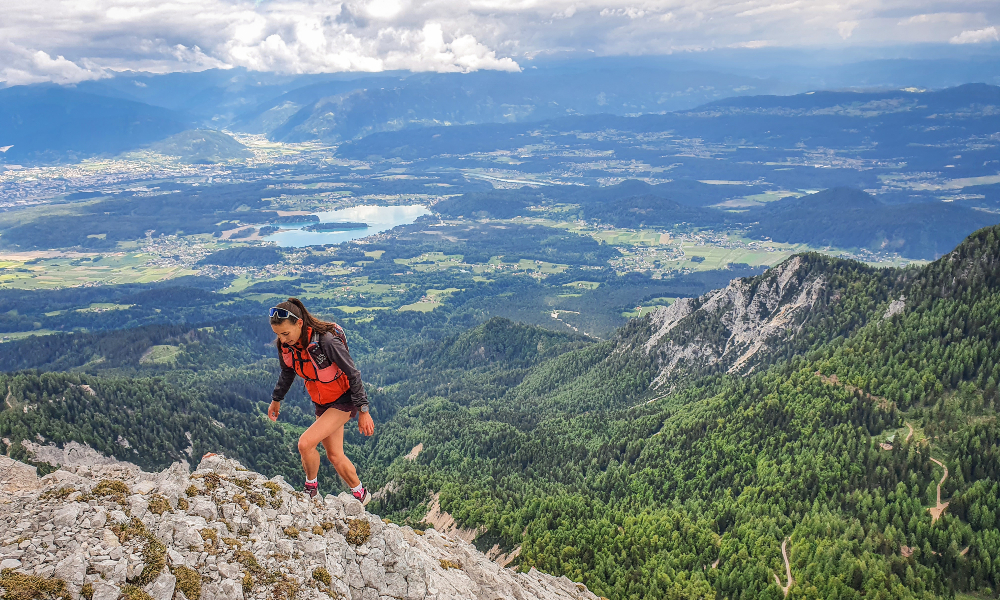With Suunto World Vertical Week 2022 around the corner (March 14-20), we reached out to Austrian ski mountaineer, sport scientist and coach Susi Kraft and asked about what goes into getting faster vertically. Susi is one half of the Berghasen, an awesome German-language blog covering everything you need to know about ski touring: training tips, tours, gear and so on.
Like many Austrians, Susi grew up in the mountains, began skiing as a child and got into ski touring at university, and more recently trail running. Now the 29-year-old can’t stop. “With sports science I got deep insights into how training really works,” she says. “It made me rethink my own training.”
The tendency, Susi says, among endurance athletes is to slip into doing too much high intensity training, even when they know they shouldn’t. And this is further compounded by vertical speed training because climbing steep gradients radically elevates heart rate.
Why improving vertical speed is hard
“It’s hard to train your aerobic base when you go uphill,” she says. “When your body isn’t used to endurance efforts, your heart rate increases quickly, the intensity gets turned up, your lactate levels start to max, which means the pH value in the body starts to fall. If it gets too low, the muscles and respiration don’t work economically anymore.”
On top of this, while doing a lot of high intensity hill training can give short term gains, in the long term it can actually worsen your performance. So how to improve your vertical speed without blowing yourself out? Read on for Susi’s four tips and three training plans below!

Susi trains in the mountains around Salzburg. © Berghasen
Good things take time
Suunto ambassador and mountain athlete Kilian Jornet is the Rolls Royce engine of vertical speed. We’d all like to be able to power uphill like he does. But Susi points something out we easily forget; Kilian got to where he is because he spent a decade or more training his base fitness, and that is achieved through low intensity training, not going overboard on hill repeats.
“It takes patience to train your base,” Susi says. “You need a year, five years, or even longer to really accomplish that. The better your training, the better your base, the better your body will be able to handle intense exercise. So take the time to train your body to work economically. When you have a good base, you will be better able to do uphill training!”
Embrace the flat
This sounds counterintuitive, right? You might be thinking how you’ll ever get better sticking to flat terrain. Susi has a reply: “Flat training is important because it’s not that intense,” she explains. “You should combine terrain – half on flat, half in the hills. World class athletes never stop training their base, they just carefully combine it with more intense sessions.”
Build strength
If you’re really serious about wanting to improve vertical speed, then there’s no skipping legs day at the gym. Strength training for the lower and upper body are essential to getting faster.
“The stronger you are, the easier it becomes,” Susi says. “If you can keep your upper body stable, your legs and arms can work more efficiently. This is really important for pushing uphill for a long time.”
Improve your technique
“Technique is really important for any sport you’re doing uphill. “You need to find the most economic way to move your body. I suggest practicing your technique on the flat so you can really focus on it without feeling exhausted.”
Beginner, advanced and expert training plans
Susi suggests following one of these plans for two weeks, then have a rest week with one to two additional rest days. Repeat the plan for several weeks with slowly increasing the length of the sessions after week six.
Beginner
Monday: Off day
Tuesday: Core and mobility training
Wednesday: 30 min run before breakfast at low intensity (70 % of your max heart rate).
Thursday: Off day
Friday: Strength training: legs and upper body
Saturday: 30 min running or 40 min cycling at low intensity (70 % of your max heart rate).
Sunday: 1,5h biking or 2 h hiking/skimo at low intensity
Advanced
Monday: Core stability followed by general strength training (hypertrophy) for legs and upper body. Flexibility exercises for cool down.
Tuesday: Fartlek (interval) workout: 1 km at 60 % of your max heart rate then 1 km at 85 % of your max heart rate. Repeat five times. 10 min easy jog cool down.
Wednesday: 45 min run before breakfast at low intensity (70 % of you max heart rate).
Thursday: Off day
Friday: Core stability followed by general strength training (hypertrophy) for legs and upper body. Flexibility exercises for cool down.
Saturday: 60 min running or 2 h cycling at low intensity (70 % of you max heart rate).
Sunday: 2,5h biking or 3 h hiking/skimo at low intensity
Expert
Monday: Core stability followed by general strength training (hypertrophy) for legs and upper body. Flexibility exercises for cool down.
Tuesday: Fartlek (interval) workout: 1 km at 70 % of your max heart rate then 1 km at 85 % of your max heart rate. Repeat five times. 10 min easy jog cool down.
Wednesday: 50 min run before breakfast at low intensity (70 % of you max heart rate).
Thursday: Off day
Friday: Core stability followed by general strength training (hypertrophy) for legs and upper body. Flexibility exercises for cool down.
Saturday: 80 min running or 2 h cycling at low intensity (70 % of you max heart rate).
Sunday: 2,5h biking or 3 h hiking/skimo at low intensity. During the workout: 5x3 min. at 90 % of your maximum heart rate with at least 3 min. of easy jog between the 3 min. intervals
Lead images: © Berghasen